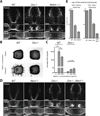Neural migration. Structures of netrin-1 bound to two receptors provide insight into its axon guidance mechanism
- PMID: 24876346
- PMCID: PMC4369087
- DOI: 10.1126/science.1255149
Neural migration. Structures of netrin-1 bound to two receptors provide insight into its axon guidance mechanism
Abstract
Netrins are secreted proteins that regulate axon guidance and neuronal migration. Deleted in colorectal cancer (DCC) is a well-established netrin-1 receptor mediating attractive responses. We provide evidence that its close relative neogenin is also a functional netrin-1 receptor that acts with DCC to mediate guidance in vivo. We determined the structures of a functional netrin-1 region, alone and in complexes with neogenin or DCC. Netrin-1 has a rigid elongated structure containing two receptor-binding sites at opposite ends through which it brings together receptor molecules. The ligand/receptor complexes reveal two distinct architectures: a 2:2 heterotetramer and a continuous ligand/receptor assembly. The differences result from different lengths of the linker connecting receptor domains fibronectin type III domain 4 (FN4) and FN5, which differs among DCC and neogenin splice variants, providing a basis for diverse signaling outcomes.
Copyright © 2014, American Association for the Advancement of Science.
Figures




References
-
- Serafini T, Kennedy TE, Galko MJ, Mirzayan C, Jessell TM, Tessier-Lavigne M. The netrins define a family of axon outgrowth-promoting proteins homologous to C. elegans UNC-6. Cell. 1994;78:409–424. - PubMed
-
- Serafini T, Colamarino SA, Leonardo ED, Wang H, Beddington R, Skarnes WC, Tessier-Lavigne M. Netrin-1 is required for commissural axon guidance in the developing vertebrate nervous system. Cell. 1996;87:1001–1014. - PubMed
-
- Forcet C, Stein E, Pays L, Corset V, Llambi F, Tessier-Lavigne M, Mehlen P. Netrin-1-mediated axon outgrowth requires deleted in colorectal cancer-dependent MAPK activation. Nature. 2002;417:443–447. - PubMed
-
- Moore SW, Tessier-Lavigne M, Kennedy TE. Netrins and their receptors. Advances in experimental medicine and biology. 2007;621:17–31. - PubMed
Publication types
MeSH terms
Substances
Associated data
- Actions
- Actions
- Actions
Grants and funding
LinkOut - more resources
Full Text Sources
Other Literature Sources
Molecular Biology Databases

